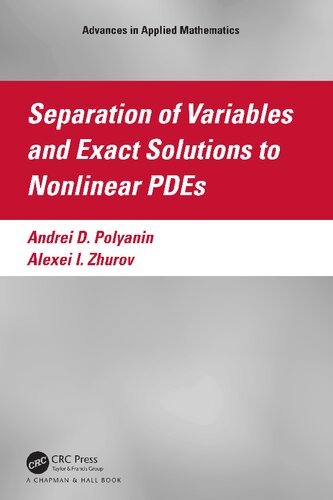

Most ebook files are in PDF format, so you can easily read them using various software such as Foxit Reader or directly on the Google Chrome browser.
Some ebook files are released by publishers in other formats such as .awz, .mobi, .epub, .fb2, etc. You may need to install specific software to read these formats on mobile/PC, such as Calibre.
Please read the tutorial at this link. https://ebooknice.com/page/post?id=faq
We offer FREE conversion to the popular formats you request; however, this may take some time. Therefore, right after payment, please email us, and we will try to provide the service as quickly as possible.
For some exceptional file formats or broken links (if any), please refrain from opening any disputes. Instead, email us first, and we will try to assist within a maximum of 6 hours.
EbookNice Team

Status:
Available4.6
31 reviewsMain subject categories: • Nonlinear PDES • Exact Solutions of Nonlinear PDEs • Separation of Variables
Separation of Variables and Exact Solutions to Nonlinear PDEs is devoted to describing and applying methods of generalized and functional separation of variables used to find exact solutions of nonlinear partial differential equations (PDEs). It also presents the direct method of symmetry reductions and its more general version. In addition, the authors describe the differential constraint method, which generalizes many other exact methods.
The presentation involves numerous examples of utilizing the methods to find exact solutions to specific nonlinear equations of mathematical physics. The equations of heat and mass transfer, wave theory, hydrodynamics, nonlinear optics, combustion theory, chemical technology, biology, and other disciplines are studied.
Particular attention is paid to nonlinear equations of a reasonably general form that depend on one or several arbitrary functions. Such equations are the most difficult to analyze. Their exact solutions are of significant practical interest, as they are suitable to assess the accuracy of various approximate analytical and numerical methods.
The book contains new material previously unpublished in monographs. It is intended for a broad audience of scientists, engineers, instructors, and students specializing in applied and computational mathematics, theoretical physics, mechanics, control theory, chemical engineering science, and other disciplines.
Individual sections of the book and examples are suitable for lecture courses on partial differential equations, equations of mathematical physics, and methods of mathematical physics, for delivering special courses and for practical training.